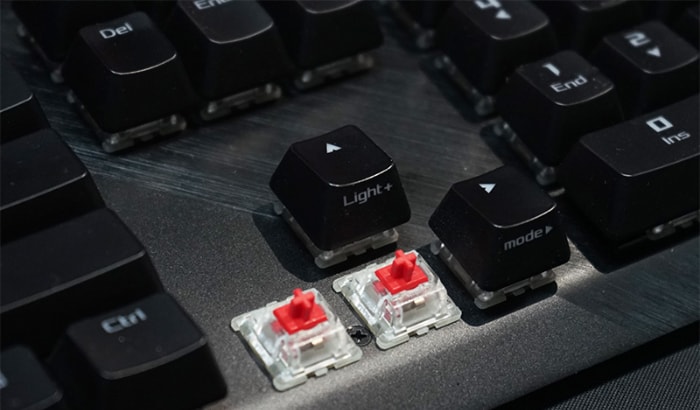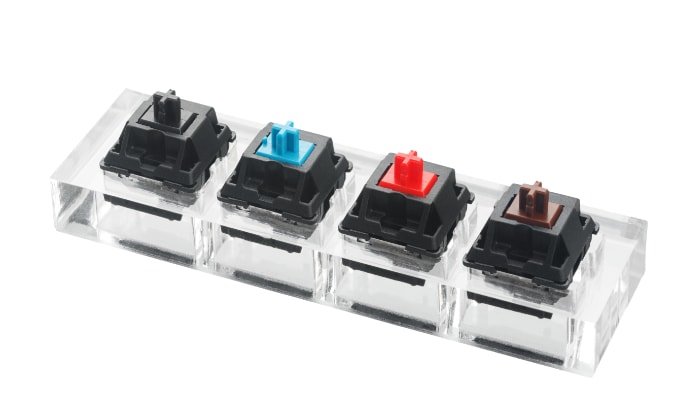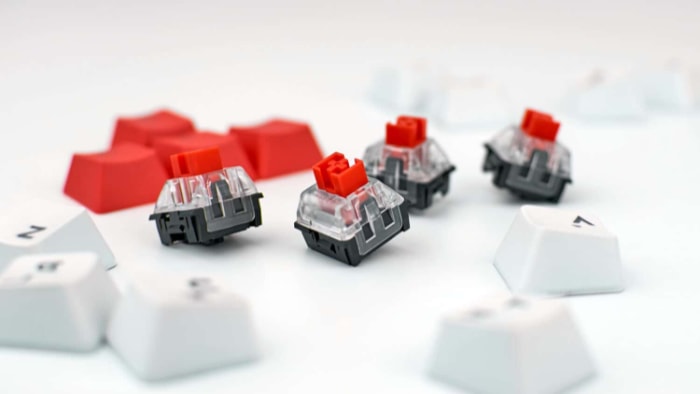Cherry MX Brown vs. Red Switches: What’s Your Type?

Mechanical keyboards have taken the computer world by storm, offering users a level of customization and control that standard membrane keyboards simply can’t match. At the heart of this revolution are the switches that lie beneath each keycap, and few names are as revered in this field as Cherry MX.
Among the pantheon of switches produced by Cherry MX, two frequently come to the forefront of discussions: Brown and Red. These switches are often the subjects of passionate debates among enthusiasts, each arguing for the merits of one over the other.
But what really distinguishes Cherry MX Brown from Cherry MX Red switches, and how do these differences impact your typing or gaming experience?
Cherry MX Brown Switches: Features and Characteristics
Often regarded as the versatile workhorse in the mechanical switch universe, Cherry MX Brown switches offer a unique blend of tactile feedback and relatively quiet operation. These features make them a popular choice for various applications, from typing long documents to late-night gaming sessions.
Actuation Type
Cherry MX Brown switches are categorized as tactile switches. This means they provide a slight bump during the actuation point, which is the moment the switch registers a keypress.
Unlike clicky switches, which produce a loud click sound, Browns offer a less intrusive auditory experience while still giving you a tactile cue that a keypress has been registered.
Actuation Force
The actuation force refers to the amount of pressure you need to apply to register a keypress. For Cherry MX Brown switches, the actuation force is approximately 45 grams.
This moderate force requirement strikes a balance between preventing accidental keypresses and providing a comfortable, low-resistance typing experience.
Sound Profile
While mechanical switches are generally louder than their membrane counterparts, Cherry MX Brown switches are considered one of the quieter options. They lack the distinct “click” sound that some mechanical switches produce, making them suitable for office environments or other settings where noise could be a concern.
Common Uses
Cherry MX Brown switches find their home in a variety of applications. They are often recommended for people who type a lot—such as writers or programmers—but who also indulge in gaming.
The tactile feedback is sufficient to provide a satisfactory typing experience, while the lack of loud clicking sounds won’t disturb others in a shared space.
Durability
Cherry MX switches are known for their durability, and the Brown variety is no exception. These switches are rated for up to 50 million keypresses, ensuring that they can withstand years of heavy use.
Pros and Cons
Pros:
- Versatile, suitable for both typing and gaming
- Moderate actuation force minimizes typing fatigue
- Quieter than many other mechanical switches
- Durable, with a high lifespan
Cons:
- Some users find the tactile feedback too subtle
- May not be ideal for those who prefer a linear or clicky switch
Cherry MX Red Switches: Features and Characteristics
Cherry MX Red switches are a staple in the realm of mechanical keyboards, particularly popular among gamers and those who prefer a smoother keystroke. These switches offer a linear actuation, which means there’s no tactile bump or audible click to indicate that a keypress has been registered.
Actuation Type
Unlike the tactile experience provided by Cherry MX Brown switches, Red switches are linear. This translates to a smooth, uninterrupted keypress, allowing for rapid actuations without the tactile “bump” to slow you down.
This is especially advantageous in fast-paced activities like gaming, where quick keypresses can make all the difference.
Actuation Force
Cherry MX Red switches require an actuation force of approximately 45 grams, which is the same as their Brown counterparts. However, the absence of tactile resistance can make Reds feel lighter and quicker, facilitating faster keypresses with minimal effort.
Sound Profile
Red switches are quieter compared to tactile and clicky switches, making them suitable for noise-sensitive environments. They are often recommended for shared spaces like offices or for late-night gaming sessions when noise can be a concern.
Common Uses
Red switches are often favored by gamers due to their linear action, which is optimized for rapid keypresses. However, they are also gaining traction among professionals who value a smoother typing experience without the tactile feedback.
In essence, these switches are geared towards users who prioritize speed and minimal resistance.
Durability
In terms of lifespan, Cherry MX Red switches are designed to withstand up to 50 million keypresses, similar to their Brown counterparts. This makes them a reliable option for long-term use, whether you’re an avid gamer or a busy professional.
Pros and Cons
Pros:
- Ideal for fast-paced tasks like gaming
- Moderate actuation force to reduce finger fatigue
- Quiet operation suitable for various environments
- High durability ensures long-term use
Cons:
- Lack of tactile feedback can lead to more typing errors
- Not recommended for those who prefer tactile or clicky switches
Performance Metrics Comparison

Choosing between Cherry MX Brown and Red switches often comes down to an array of performance metrics that impact user experience. From the nuances of actuation distance to durability, speed, and noise levels, each metric has implications for typing accuracy and overall satisfaction.
Actuation Distance
Both Cherry MX Brown and Red switches have a similar actuation distance, typically around 2.0 mm. This is the distance the key needs to travel before it registers a keypress.
The similar actuation distance means that, in theory, the speed of key registration should be comparable between the two.
Durability
Cherry MX Brown and Red switches are both rated for up to 50 million keypresses. This commonality in durability ensures that either choice would serve well for long-term use.
Whether you are a heavy typist or an avid gamer, both switches are designed to withstand substantial wear and tear.
Speed of Key Registration
Speed is often a major consideration, especially for gamers. While the actuation distance is the same for both types of switches, the linear nature of Red switches can facilitate quicker successive keypresses.
The absence of a tactile bump means that users can execute rapid-fire actions with less effort compared to Brown switches, which offer tactile resistance.
Typing Accuracy
For tasks that require a high level of typing accuracy, such as programming or content creation, Brown switches may have an edge. The tactile feedback they offer can be beneficial in reducing typos, as it provides a physical cue that a key has been actuated.
In contrast, the lack of such feedback in Red switches can sometimes lead to more accidental keypresses.
Noise Level
Both switches are on the quieter end of the mechanical switch spectrum, making them suitable for various environments, from offices to homes. However, the tactile nature of Brown switches might produce a slightly louder sound when the tactile bump is crossed.
Red switches offer a smoother keystroke, often resulting in a quieter operation.
Pros and Cons at a Glance
Cherry MX Brown
- Pros: Tactile feedback, versatile, moderate actuation force, quiet
- Cons: Not as fast for rapid keypress actions
Cherry MX Red
- Pros: Fast actuation, quiet, moderate actuation force
- Cons: Lack of tactile feedback, not ideal for tasks requiring high typing accuracy
User Experience
The tangible metrics of switches are just one side of the story. Equally important is the subjective realm of user experience, which can vary significantly based on individual preferences and specific use-cases.
Typing Comfort
Typing comfort is often highly subjective, depending on an individual’s typing habits and the nature of the tasks they frequently undertake. Cherry MX Brown switches tend to be favored by users who appreciate a tactile point that marks a keypress.
This tactile sensation often results in a more satisfying and less fatiguing typing experience for longer periods.
In contrast, Cherry MX Red switches are linear and offer a smooth keypress. While this is often preferred for rapid actuations in gaming, some users find it less satisfying for typing and more prone to errors due to the absence of tactile feedback.
Gaming Experience
When it comes to gaming, Cherry MX Red switches usually take the spotlight. The linear actuation allows for rapid and smooth keypresses, which is often vital in fast-paced games.
The lack of tactile resistance enables quicker reaction times, a factor that can be crucial during intense gaming sessions.
On the other hand, Cherry MX Brown switches offer a balanced experience. While they might not be as quick as Red switches for rapid-fire gaming actions, the tactile feedback provides a level of engagement that some gamers appreciate.
Noise Sensitivity
Noise can be a crucial factor in user experience, especially in shared or quiet environments. Both Cherry MX Brown and Red switches are relatively quiet, but slight differences exist.
Brown switches might produce a tiny bit more noise due to the tactile bump, while Red switches generally have a smoother, and therefore quieter, keypress.
Versatility
In terms of versatility, Cherry MX Brown switches often come out on top. Their tactile nature makes them suitable for a broader range of applications, from typing to gaming.
Red switches, although excellent for specific tasks like gaming, might not be as versatile due to their linear actuation.
Subjective Preferences
It’s important to note that personal preference plays a significant role in determining the best switch for an individual. Some users are ardent fans of the tactile feedback provided by Brown switches, while others swear by the rapid actuation of Red switches.
Ultimately, the ‘best’ switch is subjective and dependent on what you find most comfortable and suitable for your needs.
Price and Availability

The final but often decisive factor in choosing between Cherry MX Brown and Red switches is their cost and how readily available they are in the market. While both types of switches are commonly found in a wide variety of keyboards, there are subtle differences in price points and availability that could influence your decision.
General Price Range
In general, keyboards equipped with Cherry MX Brown and Red switches often fall within a similar price range, typically between $80 and $200 for well-known brands. However, prices can vary depending on additional features such as backlighting, keycap material, and brand reputation.
It’s also worth noting that limited edition or specialized models can command a premium.
Price Fluctuations and Sales
Seasonal sales, discounts, and promotions can influence the cost of keyboards with either type of switch. Keep an eye out for sales events, as these could provide an opportunity to grab a keyboard with your preferred switch at a discounted price.
Generally speaking, neither switch tends to be more discounted than the other, making them equally accessible during sale events.
Stock Availability
Both Cherry MX Brown and Red switches are generally widely available given their popularity. However, high demand can sometimes lead to stock shortages, particularly during holiday seasons or when new models are released.
It’s advisable to check multiple retailers or consider pre-ordering if you have a specific model in mind.
Specialty Stores and Custom Orders
If you’re interested in customizing your mechanical keyboard, specialized stores often offer individual Cherry MX switches for sale. This allows users to build or modify their own keyboards.
Both Brown and Red switches are usually readily available in such outlets, although prices can be higher than buying a pre-made keyboard.
Global Availability
Cherry MX Brown and Red switches are popular worldwide, making them easily accessible in various countries. However, availability might differ based on regional demand and distribution networks.
Some regions might have a more extensive selection of keyboards with one type of switch over the other.
Conclusion
Choosing between Cherry MX Brown and Red switches involves a complex interplay of factors, from performance metrics such as actuation distance and speed, to more subjective elements like typing comfort and user experience. Both switches have their merits and drawbacks, making the selection highly individualistic.
While Cherry MX Red switches excel in gaming scenarios and offer rapid actuation, Cherry MX Brown switches provide tactile feedback that many find satisfying and versatile for various tasks. Noise levels, typing accuracy, and durability are other aspects where these switches show subtle yet significant differences.
Furthermore, price and availability, although generally comparable, can vary depending on seasonal sales, brand reputation, and global distribution. By carefully weighing these diverse criteria, you can select a switch that aligns closely with your specific needs, whether they be for gaming, typing, or a balance of both.


